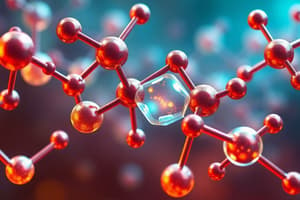Podcast
Questions and Answers
Which of the following is NOT a type of macromolecule?
Which of the following is NOT a type of macromolecule?
- Nucleic Acids
- Carbohydrates
- Enzymes (correct)
- Lipids
What is the primary function of carbohydrates in biological systems?
What is the primary function of carbohydrates in biological systems?
- Storage of genetic information
- Providing structural support and energy (correct)
- Insulating body organs
- Catalyzing biochemical reactions
Which functional group is found in both amino acids and carboxylic acids?
Which functional group is found in both amino acids and carboxylic acids?
- Methyl
- Hydroxyl
- Carboxyl (correct)
- Phosphate
What role do lipids play in the body besides energy storage?
What role do lipids play in the body besides energy storage?
DNA and RNA are both types of which macromolecule?
DNA and RNA are both types of which macromolecule?
Which of the following functional groups is primarily associated with epigenetic changes in gene expression?
Which of the following functional groups is primarily associated with epigenetic changes in gene expression?
What defines the structure of a protein?
What defines the structure of a protein?
Which type of carbohydrate is commonly used for energy storage in animals?
Which type of carbohydrate is commonly used for energy storage in animals?
Which macromolecule is primarily responsible for storing and processing genetic information?
Which macromolecule is primarily responsible for storing and processing genetic information?
What type of bond is formed between monomers during the dehydration synthesis of carbohydrates?
What type of bond is formed between monomers during the dehydration synthesis of carbohydrates?
Which statement accurately describes lipids?
Which statement accurately describes lipids?
Which of the following is a complex carbohydrate that serves as a structural component in plants?
Which of the following is a complex carbohydrate that serves as a structural component in plants?
What is the primary role of amino acids in the formation of proteins?
What is the primary role of amino acids in the formation of proteins?
Which carbohydrates are primarily broken down to produce energy during cellular respiration?
Which carbohydrates are primarily broken down to produce energy during cellular respiration?
What structural feature distinguishes proteins from other macromolecules?
What structural feature distinguishes proteins from other macromolecules?
In lipid metabolism, what type of bond is formed during dehydration synthesis between subunits?
In lipid metabolism, what type of bond is formed during dehydration synthesis between subunits?
Study Notes
Functional Groups
- Hydrocarbons are rarely found alone; they often serve as a backbone for functional groups.
- Functional groups are small molecules involved in chemical reactions of living systems.
- Important functional groups to know:
- Hydroxyl (-OH): found in alcohols; mixes well with water.
- Carbonyl (C=O): forms aldehydes (end of carbon chain) and ketones (middle of carbon chain).
- Carboxyl (-COOH): combines hydroxyl and carbonyl; known as carboxylic acids, releases H+ ions.
- Amino (-NH2): compounds called amines; acts as a base.
- Sulfhydryl (-SH): thiols that form cross-links in proteins, influencing hair structure.
- Phosphate (-OPO3): organic phosphates crucial for DNA backbone and ATP energy storage.
- Methyl (-CH3): affects gene expression, relates to epigenetics.
Macromolecules
- Macromolecules are large molecules formed from carbon skeletons and functional groups.
- Four main types of macromolecules:
- Carbohydrates: provide energy and structural support (e.g., cellulose).
- Proteins: comprise complex structures with varied functions; consist of amino acids.
- Lipids: hydrophobic molecules that include fats, membranes, and hormones.
- Nucleic Acids: DNA and RNA responsible for genetic information storage and processing.
Macromolecule Structure
- Macromolecules are chains of smaller units termed monomers.
- A chain of monomers is known as a polymer.
- Dehydration synthesis occurs when monomers fuse together, losing water.
- Hydrolysis reactions split polymers into monomers, using water.
Carbohydrates
- Also called saccharides; consist of carbon, hydrogen, and oxygen in ring structures.
- Monomer: monosaccharide; polymer: polysaccharide; linked by glycosidic bonds.
- Glucose is a crucial monosaccharide utilized for energy in cell respiration.
- Glucose forms:
- Starch: a branching polysaccharide for energy storage in plants.
- Cellulose: a straight polysaccharide that provides structural support in plants.
Proteins
- Composed of branching chains that include nitrogen.
- Monomer: amino acid; polymer: polypeptide; linked by peptide bonds.
- Proteins serve hundreds of functions and make up most cell structures.
- There are 20 different amino acids, each having unique roles in biological processes.
Lipids
- Characterized by hydrophobic properties; lack consistent structure and don’t have monomers or polymers.
- Three main types of lipids:
- Steroids (e.g., testosterone, estrogen, cholesterol): four fused rings structure.
- Fats: consist of glycerol and three fatty acids; function mainly in energy storage.
- Phospholipids: composed of phosphate, glycerol, and two fatty acids; essential for cell membranes.
- Lipids are linked by ester bonds through dehydration synthesis.
Studying That Suits You
Use AI to generate personalized quizzes and flashcards to suit your learning preferences.
Related Documents
Description
Explore the essential concepts of biological molecules and functional groups in this quiz. Understand the significance of carbon skeletons and how they serve as backbones for various functional groups in living systems. Test your knowledge about biomolecules, macromolecules, and chemical reactions.




